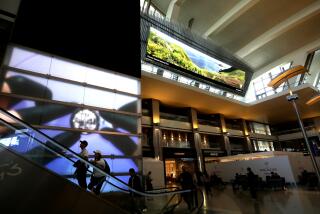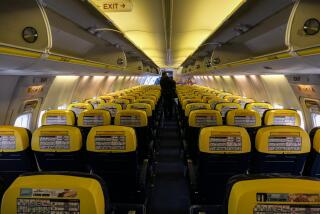Missing those airport announcements? Here’s how to overcome that sound barrier
Phil Bravin has logged a million miles on Delta and is as savvy a traveler as they come. But certain scenarios still vex the Vermont businessman.
Typically, it starts with a gate agent.
“They’ll be talking for five minutes,’’ he said, describing a scene familiar to millions of deaf and hard-of-hearing travelers, “and I’ll go up and ask what they said and they’ll give me a two-word answer.’’
He can’t always tell from that brief exchange exactly what is going on.
Communication breakdowns can unravel even the most chill traveler, but consider that one of six baby boomers has hearing loss and that Generation Xers and millennials are not far behind. An estimated 14% of adults ages 20 to 69 have some level of hearing loss, according to the national Centers for Disease Control and Prevention.
Or, put another way, millions of us can’t hear those darned airport announcements.
“There are many stories from deaf and hard-of-hearing people missing flights, trains and other transportation because announcements were not available in visual form,” said Howard A. Rosenblum, chief executive and director of legal services for the National Assn. of the Deaf.
The civil rights group has pushed for more announcement and alerting systems to be made accessible through visual and tactile means.
People pick up the most information during a trip from paging systems. When airports fail to provide equivalent access to travelers with hearing disabilities, the consequence isn’t just annoyance; it can prompt legal action.
In 2002, deaf travelers sued San Francisco International Airport to make it more accessible.
The outcome of that class-action settlement is a universal design that benefits everyone: 80 additional visual paging screens at the domestic and international terminals, for a total of 140.
“Visual paging has been great,” said Christopher Birch, SFO’s director of guest experience. “It should exist everywhere.
“The monitors provide a text alternative for passengers to retrieve pages and other important audible information that can get drowned out in the din of terminal noise.
“Your name only shows up when you’re not expecting it, so you have to get in front of people,. Whatever works faster is better, because we want to reduce the amount of paging and announcing overall.”
As part of the settlement, SFO increased the number of TTY telephones (special phones that allow communication to be typed) and improved signage and information on its website. The airport installed video relay service on the arrival level of both terminals in case travelers need an American Sign Language interpreter to help facilitate some aspect of a trip, such as calling a cab.
Those all-important alerts about flight delays and gate changes, however, are the domain of airlines. Birch and other experts suggest travelers be proactive in their planning and download their airline’s app, because important information is pushed out to mobile devices.
What else can you do?
The Air Carrier Access Act requires airlines to ensure that passengers who identify themselves as needing visual or hearing assistance have prompt access to the same information provided to other passengers.
The Hearing Loss Assn. of America has more information about the regulations on its website.
Advocates recommend that deaf and hard-of-hearing travelers approach the staff at airports (and train stations) before boarding and establish their communication needs up front so they can be alerted to any changes or updates.
But because that doesn’t always work, Bravin and his colleagues, including Chris Wagner, who is also deaf, use technology to work around barriers.
As executives at Purple Communications, which provides an array of services to deaf and hard-of-hearing individuals, these frequent fliers rely heavily on apps and smart phones.
“I’m always on the run,’’ said Wagner, who makes biweekly business trips between his home state of Florida and California. He likes the Sam trip planner and assistant app, available for Android and iOS.
“It lets me know if there’s a time change with a flight or a gate change with a flight,’’ said Wagner, who notes that information can lag if there’s poor cell reception.
If he misses a flight, the app will connect him with a dedicated travel assistant. “It’s easier for me than having to go to the gate, wait in a long line and struggle to communicate,’’ he said.
Purple’s P3 app, free on Android and iOS, lets users place video calls with an American Sign Language interpreter. This is handy if Bravin needs to call the airline and connect with a representative.
“With the app, I am able to talk directly to anyone, any time,’’ he said.
If tech problems interfere, he takes cues from fellow travelers.
“In lieu of the app,” he said, “sometimes, you just have to follow the crowd.’’
On the horizon for air travelers with hearing loss:
In November 2016, the Department of Transportation’s Advisory Committee on Accessible Air Transportation reached consensus on a detailed set of recommendations regarding in-flight entertainment.
Those recommendations included:
►Requiring certain movies and shows to be displayed with captioning to provide access to deaf and hard-of-hearing passengers
►Establishing deadlines for airlines to ensure that new seat-back entertainment systems are accessible
►Providing options to airlines for the use of personal electronic devices to accommodate passengers with disabilities.
The department plans to issue a notice of proposed rule-making addressing inflight entertainment, although a schedule has not yet been established.
You can see a copy of the rule at the agency’s website.
More to Read
Sign up for The Wild
We’ll help you find the best places to hike, bike and run, as well as the perfect silent spots for meditation and yoga.
You may occasionally receive promotional content from the Los Angeles Times.






